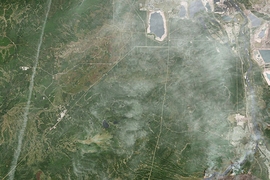From record-setting fires in the western United States to the devastating and still-blazing bushfires in Australia, it is increasingly apparent that society must forge a new relationship with fire. Factors that include changing climate, expanding human development, and accumulating fuels mean new approaches are needed, and many experts are calling for increasing resiliency by suppressing fewer fires and accelerating forest restoration.
Yes, you read that correctly — suppressing fewer fires.
Scientific evidence that’s been accumulating for decades points to the ways that suppressing fire leads to unhealthy forests. Ongoing research by the U.S. Forest Service, an agency of the U.S. Department of Agriculture, shows how short-term gain from suppression can condition the landscape for future, even-greater fires burning in extreme conditions, and MIT Sloan Executive Education has had a hand in translating that thinking into action.
Matthew Thompson is a research forester at the U.S. Forest Service, where he works in the Human Dimensions Program at Rocky Mountain Research Station in Colorado and focuses on the human dimension of natural resource problems. An engineer by training, with a PhD from Oregon State University in forest engineering, Thompson has worked with the agency for about a decade. Core to his work is understanding how best to catalyze desired changes in fire manager behavior in terms of individual fire events and over time. He believes that changes in fire manager decisions regarding response strategies and tactics will be necessary to change fire outcomes. To that end, Thompson enrolls in executive education courses whenever time allows to draw insights from the latest thinking at the intersection of management and science.
“Risk management and management science evolves,” says Thompson. “I’ve found the best way to stay up-to-date is through continuing and executive education.”
Bringing analytics to fire management
Thompson’s professional development pursuits were in part propelled by earning the Presidential Early Career Award for Scientists and Engineers in 2016. The funding he received as a result of this award enabled him to enroll in courses over several years, including Understanding and Solving Complex Business Problems and Analytics Management: Business Lessons from the Sports Data Revolution at MIT Sloan Executive Education.
“I think it’s fair to say both courses were very influential in terms of my thinking and career trajectory,” says Thompson, who attended the programs with his colleague David Calkin so that they could apply the concepts they learned in the classroom directly to their work and share a common language for their problem solving.
“Some will argue that fire is ultimately unique, but in these courses we encountered so many analogies to what we see in the fire management world,” says Thompson, “including other disciplines that tend to emphasize reactively fixing problems over prevention, for example. The more we talked with managers and took courses, the more we encountered common problems and proactive solutions.”
Thompson’s attendance in Analytics Management in 2018 was part of an effort to bring data-driven decision-making to wildland fire management.
“Ben Shields introduced an analytics management framework and gave us opportunities to work through that framework hands-on,” says Thompson. “We were able to more clearly define the challenges of bringing data analytics to bear in our respective organizations as a result of this exercise. Dave and I were there to solve a problem, and the opportunity to work collaboratively in this environment with the support of faculty was invaluable.” Thompson added that he and his colleague went out for beers after class in Cambridge, Massachusetts, and kept working through the framework, assembling notes and strategies that would prove useful in the next phase of their work. Shields is a senior lecturer in managerial communication at the Sloan School of Management.
Thompson, Calkin, and their colleagues recently authored a paper, “Risk Management and Analytics in Wildfire Response,” in which they demonstrate the real-world application of analytics to support response decisions and organizational learning.
“When it comes to fire management, we are not trying to discount the culture of experiential learning, which is of course critical,” says Thompson. “But in Ben Shields’ analytics course, we saw a direct parallel between the objections raised by sports team scouts, 20 year ago, to statistics and the fire managers who doubt how statistics can help. In sports, as in fire, decision-making was a job largely reserved for the trained eyes and gut instincts of grizzled veterans.”
Thompson and his colleagues argue for a stronger adoption of data-driven decisions in fire management that they colloquially refer to as “'Moneyball' for fire,” referencing the 2003 book by Michael Lewis chronicling the Oakland Athletics’ use of advanced statistics. In the paper they introduce core analytics concepts, cite Ben Shields’ analytics management framework, and make observations on implementing an analytics agenda within organizations.
The Forest Service is now developing Risk Management 101 courses for fire officers and designing new risk management doctrine to guide the agency. During fire season, they are experimenting with on-call analytics teams to assist incident commanders. Fire managers can use data to help prioritize where they put resources and determine where suppression efforts are likeliest to succeed. They are making steady progress toward designing the ideal response to a fire depending on when and where it happens.
A systems thinking approach to wildfires
Thompson and Calkin previously co-authored several papers on the application of enterprise risk management and systems thinking to wildfire management after completing John Sterman’s two-day systems thinking course. Sterman is the Jay W. Forrester Professor of Management at the MIT Sloan School of Management.
In “Rethinking the Wildland Fire Management System,” the authors explain how systems thinking can help the fire management community be proactive rather than reactive by more fully characterizing the environment in which fire management decisions are made and anticipating factors that may lead to compromised decision-making.
“In the fire community, people have been moving toward this system perspective over time, but a lot of the analysis and perspectives are looking at the social and ecological perspective — thinning forests, reducing flammable material, engaging homeowners and communities, etc. Many of those social-ecological perspectives have failed to account for the fire management system itself, when in fact fire management might be where the most change needs to come from. Part of that is because, in the western U.S., we’ve been so good at suppression we’ve created forests that look entirely different from what they used to look like, and we can’t treat our way out of the problem. We need to opportunistically manage ignitions in different way, use analytics to predict where on the landscape we can create curated fires that are going to be the right size, within pre-identified boundaries. There are success stories coming out of the Southwest, for example, where they have been able to create and control fires that have bought the landscape a restoration treatment that is good for the next 10-20 years. This can be a much more effective solution than logging, for example.”
The sky’s the limit for fire management solutions
Thompson is optimistic.
“The engineer in me is most interested in the technical challenges, and there is huge opportunity for growth in that area. With advances in remote sensing technology, AI, ML, the sky is the limit. For example, recent legislation was passed to equip suppression resources with tracking technology. With this temporal, high-resolution data, we can expand the universe of what we know about current efforts to manage fire and the degree of efficiency of these efforts. This will be a vast improvement on the currently limited amount of credible data we have.”
Thompson is also emboldened by the amount and quality of research and resource sharing among the Forest Service, other agencies, and countries like Australia. “And we are also very fortunate to have just hired Nicholas McCarthy, a wildfire data scientist from Australia who is an expert on bushfire thunderstorms and AI applications to wildfire.”
Thompson says that people often refer to fire as a wicked problem with no one solution. And while he has confidence in data and technology, he realizes it’s not a silver bullet. He also cautions that one can’t decouple the social from the technical. “Climate change is clearly a problem that is human-driven, and behavior change is central to mitigation. The adoption of risk management approaches and data analytics is also predicated on a cultural shift. If tomorrow we could track every firefighter and review suppression effectiveness, it might change nothing. You need leaders to value the role of data-driven decision-making and hold others accountable to it.”
The views expressed herein are those of the interviewee (Thompson) and do not represent official views or policies of the U.S. Forest Service, nor do they constitute endorsement.








